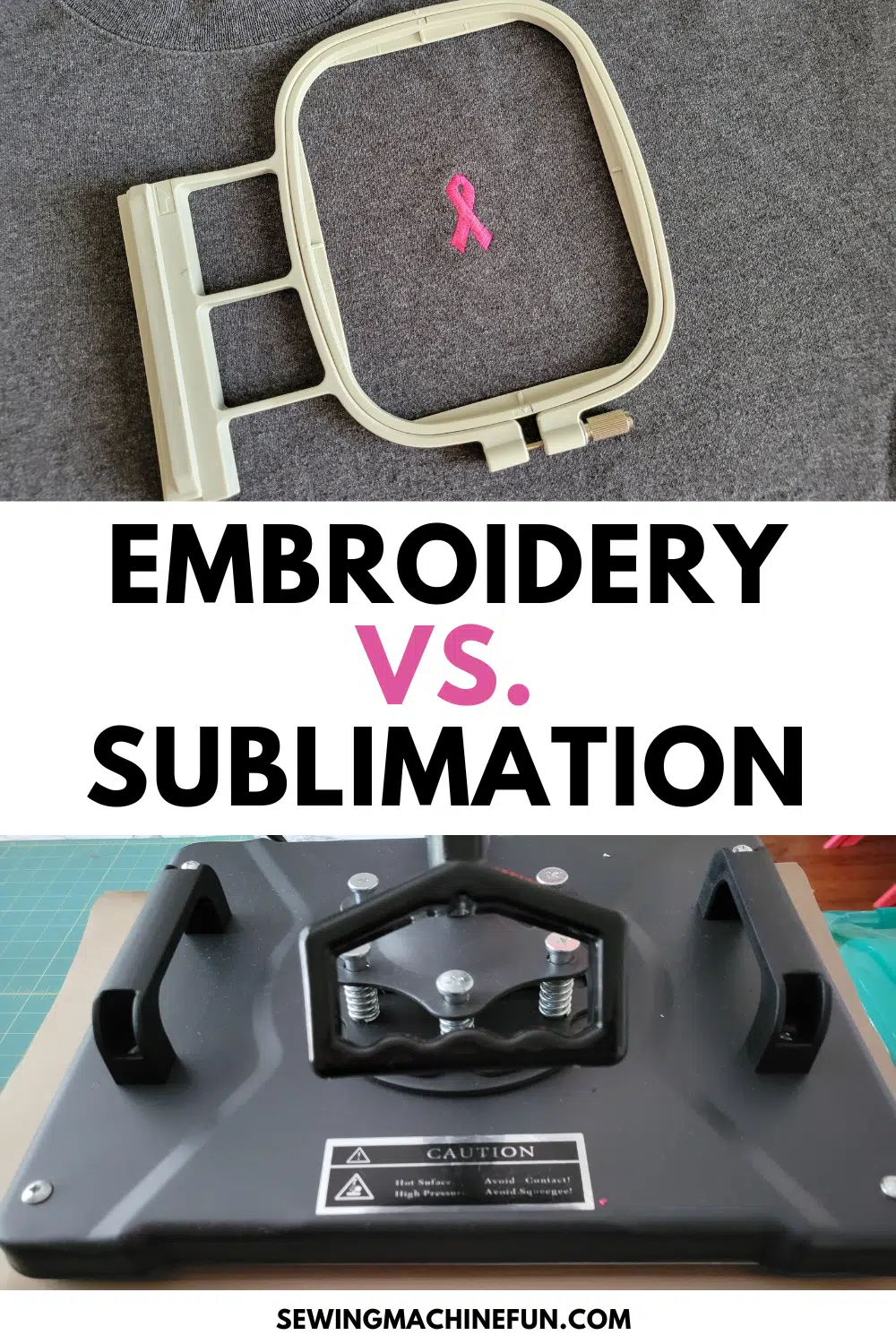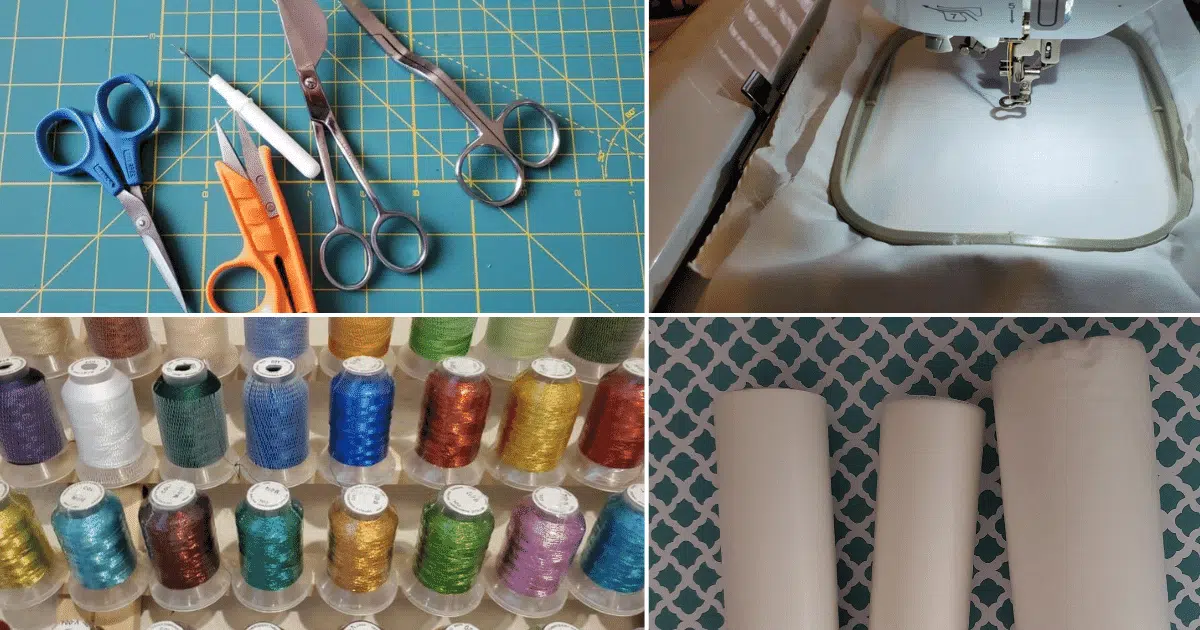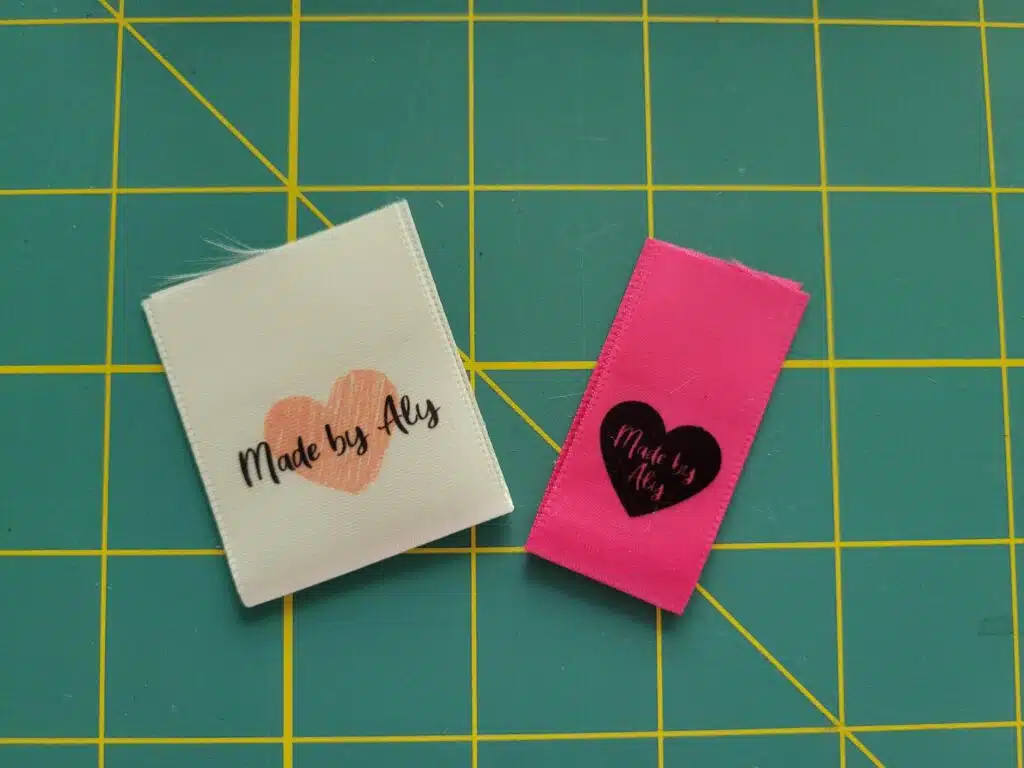Embroidery vs. Sublimation: Which is Better?
This post may contain affiliate links, which means I’ll receive a commission if you purchase through my links, at no extra cost to you. I sometimes receive free products for review. Please read disclosure for more information.
Embroidery and sublimation can both customize products. The common end goal of producing personalized goods is one of the very few similarities between these two methods, though.
Sublimation and embroidery differ in everything from the equipment and supplies used, the time they take, the expertise required, and even the projects you can create.
I’ve been machine embroidering for years, but during the pandemic, I picked up sublimation as a hobby when it seemed like the whole world started rigging household printers to function as sublimation printers.
I love both techniques and highly recommend them, but if you have to choose only one, here’s what you need to know about embroidery vs. sublimation.

Machine Embroidery Defined

Machine embroidery requires an embroidery machine, which uses a needle and thread to stitch a digitized design onto a project blank. Embroidery has been around for decades and is durable, professional, and customizable, but the cost and the required learning curve are big disadvantages.
Sublimation Defined

Sublimation is a newer technique using specialized printers, inks, and papers to produce a design that is then infused into a blank using heat and pressure. This method produces high-quality prints with no color restrictions, but the blanks you can sublimate are limited.
Embroidery vs. Sublimation
Embroidery takes longer and requires more expertise than sublimation. However, sublimation may not be as “professional” as embroidery and has more limitations in materials it can work with.
There’s really no answer to whether embroidery or sublimation is “better,” as they’re so different. Below are more details about sublimation vs. embroidery, though, so you can decide which you prefer!
1. Cost Investment for Machines and Supplies
Embroidery is more expensive than sublimation when you consider machine and supplies costs.
A. Machine Costs

The cheapest embroidery machines (with small 4″x4″ hoops) cost at least $300-$400. Machines with larger hoops and those with multiple heads and multiple needles are MUCH more expensive.
Single needle machines with the largest hoops can run over $15,000, while the multi-head machines required for commercial embroidery businesses can cost over $100,000.
In contrast, you can start with sublimation at home using an inexpensive Epson printer that’s been converted.

For example, I bought the cheapest sublimation-convertible printer I could find at the time (Epson ET-2800) for $250-$300 and used third-party sublimation ink rather than printer ink.
Even the more expensive printers intended for sublimation (like Sawgrass printers) are significantly less than embroidery machines. Same with industrial sublimation printers vs. industrial embroidery machines.
B. Supplies Costs

Additional embroidery supplies required include stabilizer, thread, any specialty hoops, and embroidery software for digitizing, which adds to the cost of embroidery.
Digitizing software is a one-time purchase but can cost over $1000. And, thread prices can add up for high stitch count designs. (To understand the cost, estimate how much thread is required for embroidery designs of different stitch counts.)
However, if you are running a business, you can expect to be able to charge more for machine-embroidered logos and designs, making the profit margins more similar.

In contrast, additional supplies required for sublimation include sublimation ink, sublimation paper, heat-resistant tape, and a heat press.

Hobbyists could get by with a Cricut Easy Press, but scaling to professional levels requires a better heat press.
Also, to sublimate ball caps or mugs, you must purchase attachments or separate special presses like Cricut’s mug press.
2. Designs You Can Sublimate or Embroider

Within reason, almost any design can be sublimated, while embroidery has more design limitations.
A. Accuracy

Sublimation has greater accuracy than embroidery, which is not as precise with small details and letters, as threads have to create all parts of a design. (Check out my sublimated clothing tags above!)
However, some things, like chest logos on polo shirts, will always look more professional when stitched by an embroidery machine.
B. Color Matching
Sublimation can more easily provide an exact color match for your desired design since sublimation inks can be mixed in perfect ratios for any desired Pantone color.
With embroidery, hundreds or thousands of threads may be necessary in a stash to achieve an exact color match, and even then, you might not find the exact color you need.
C. Design Size

For embroidery, the design size is limited by the maximum hoop size of the embroidery machine. Although splitting designs is possible, this is time-consuming and requires perfect accuracy.
While sublimation is also limited to the maximum size your printer can sublimate, it is easier to split designs and piece them back together before heat pressing.
3. Time Required for Design Creation (Digitizing)
Creating designs for image sublimation is quicker and easier than digitizing designs for machine embroidery.

If you own a business and take orders, most customers can easily provide a high-quality file that you don’t have to edit much before sublimating.
While vector files (think . AI or PDF) are the highest quality, some printers can also use raster image files.
In contrast, very few customers will be able to provide you with an appropriate file type for embroidery that you can load directly to an embroidery machine.
Thus, for every image or vector file that you receive, you will have to spend time creating the embroidery design, which is called digitizing.
Simple one-color designs could potentially be auto-digitized in seconds, and monograms can be easily constructed from built-in fonts on machines or in software. However, creating an embroidery design from a more complicated vector image requires manually placing stitches, which can take hours or days.
4. Time Required for the Actual Sublimating or Embroidering

For sublimation, after setting up the design, you only need minutes to print it on the sublimation printer.
Then, you set the sublimation blank in your heat press, place the paper, and close the heat press for the required time (less than a minute, usually.)
In terms of embroidery, after digitizing a design and transferring it to your machine, you first have to hoop an embroidery blank and stabilizer, which won’t take more than a few minutes.
However, then it’s time to stitch the design using the machine, which is where the time adds up.
Some large embroidery designs take HOURS to stitch, especially if you have a single needle machine where you have to step in every color change and manually change the thread. (You can estimate embroidery time using these methods to get an idea of how long it takes to embroider certain types of designs.)
I will also note that I spend much more time troubleshooting my embroidery machine and redoing projects for things like puckering than I do when sublimating.
5. Blanks Limitations

If you want to personalize hard, solid blanks like mugs, coasters, metal keychains, etc., embroidery is not an option. You must sublimate them.
However, regarding soft blanks, embroidery has MANY more options. As long as it’s soft, hoopable in a single layer, and you select a compatible design, you can likely embroider it.
In contrast, sublimation only works on light-colored polyester fabrics and certain types of fluffy fabric.
If you want to sublimate on cotton or dark fabrics, you have to get creative and indirectly sublimate on them, which requires additional time and expertise. These indirect workarounds include sublimating first on white glitter iron-on vinyl, sublimation spray, or Siser EasySubli or EasyColor DTV.
5. Learning Curve and Expertise
For me, sublimation was MUCH easier to learn. Once you master how to use sublimation paper, work your printer, and use the heat press to sublimate the ink, you’ll produce good-quality projects in no time. There’s very little troubleshooting required after the initial learning curve, and printers don’t act up as much as embroidery machines.
Meanwhile, embroidery takes longer to get the hang of. You must learn which stabilizers to use, how to set up and use your machine, and how to create embroidery designs. Learning to digitize vector files to embroidery designs with stitch data was my embroidery journey’s most time-consuming and significant hurdle.
6. Machine Diversity for Hobbyists

If you’re a hobbyist not looking to start a business, embroidery machines can do more than just put logos or monograms on shirts. Embroidery machines can quilt, do in-the-hoop projects, embroider on paper, and create many more cool things.
Sublimation printers pretty much just…sublimate.
In conclusion, embroidery and sublimation both have advantages and disadvantages. Deciding which machine to purchase ultimately depends on your budget and your goals.
Thankfully, for entry-level equipment to test the processes, the cost barrier is fairly low. Thus, it might be worth trying both sublimation and embroidery at home if you can swing it. (There are even places you can rent an embroidery machine for free to try out.)
You might just find out you need both of these crafting devices in your craft room like me!

